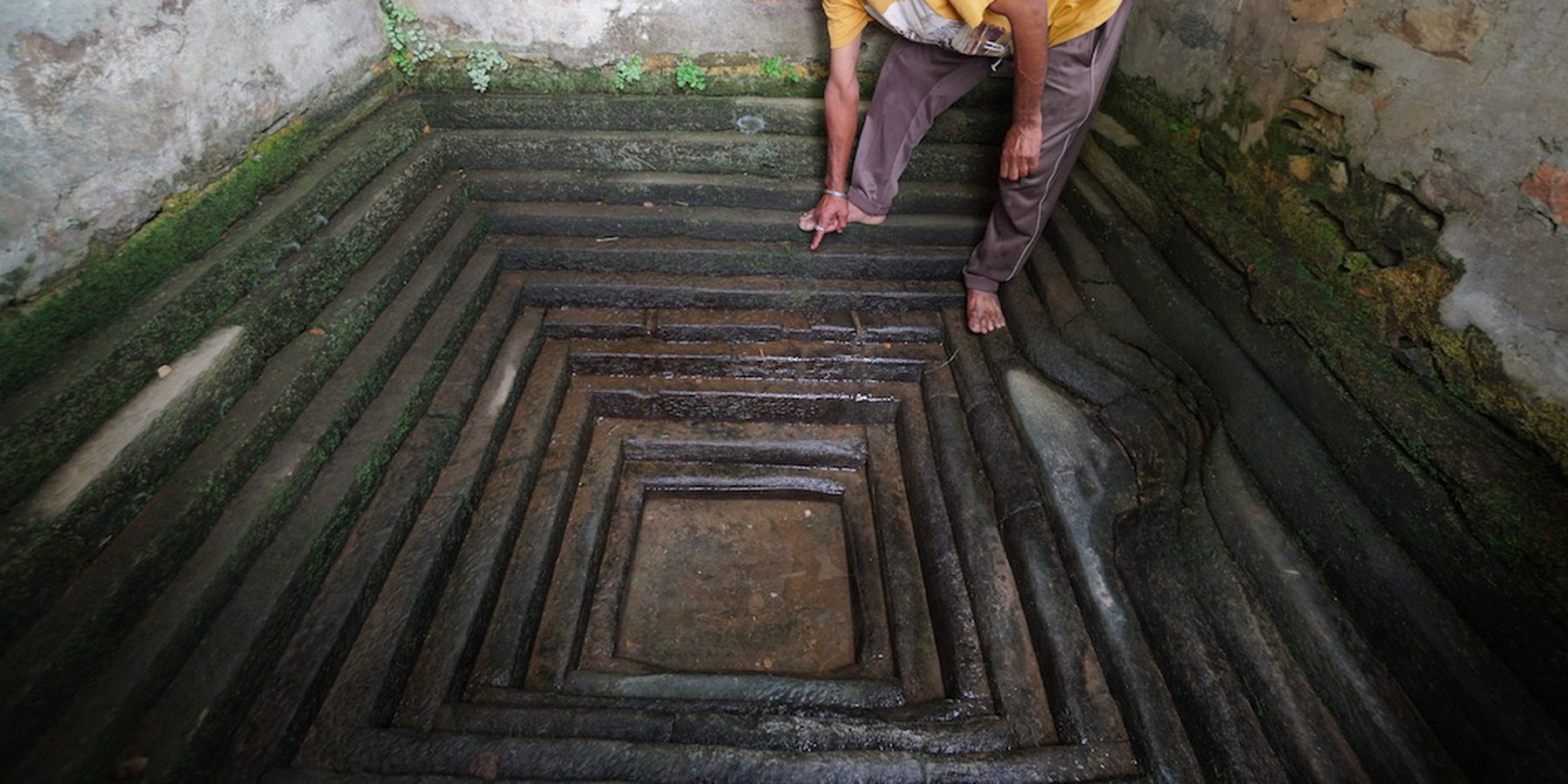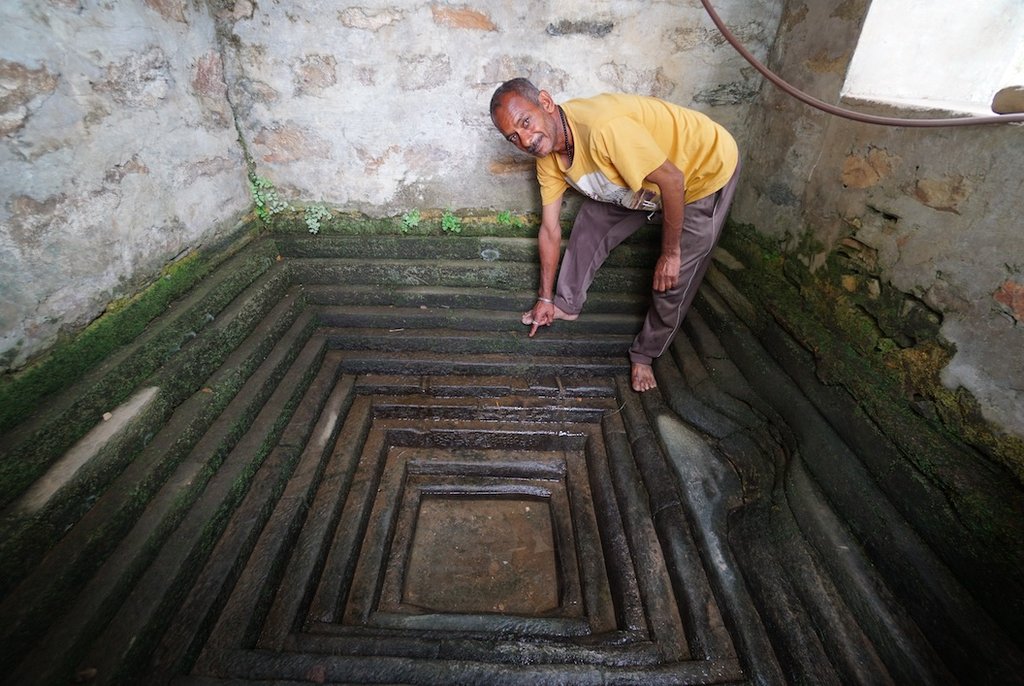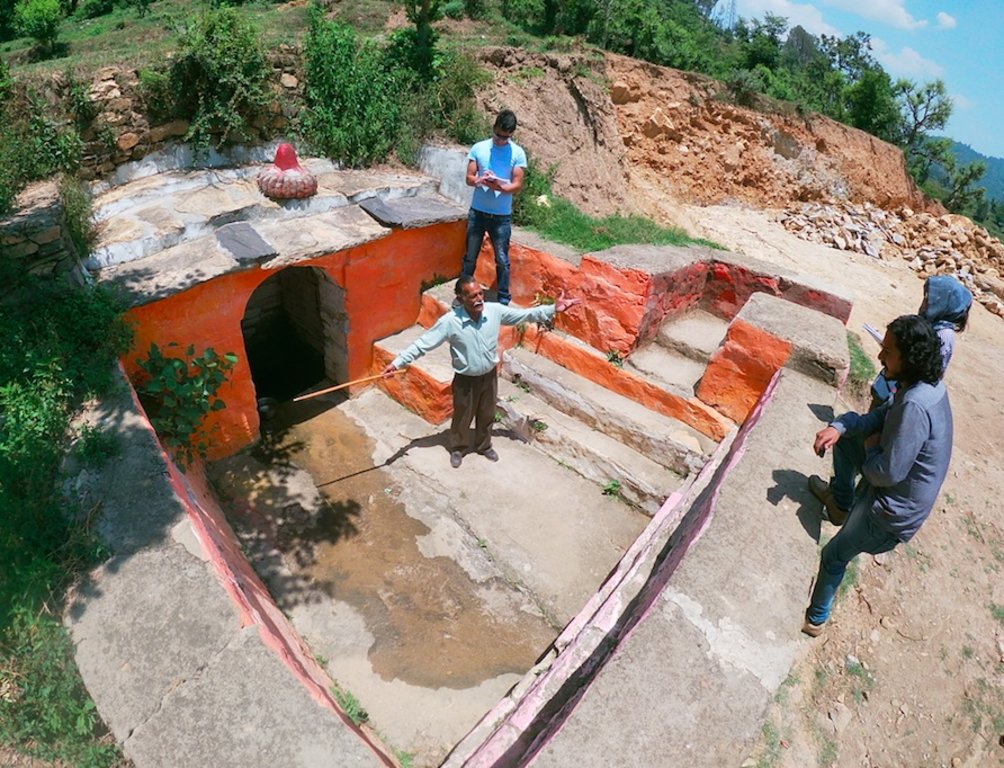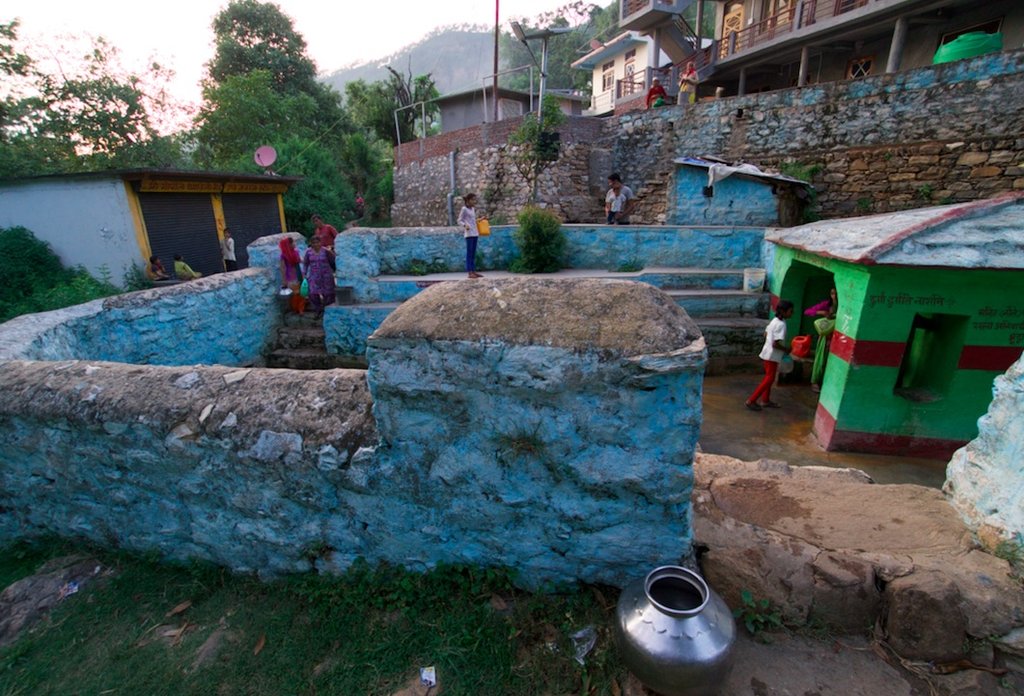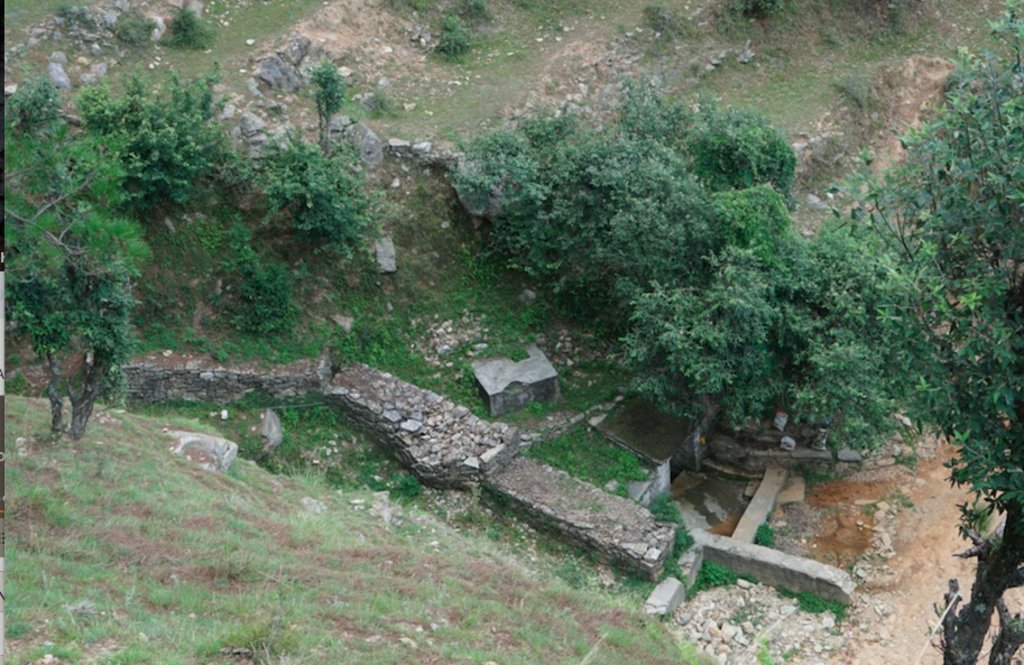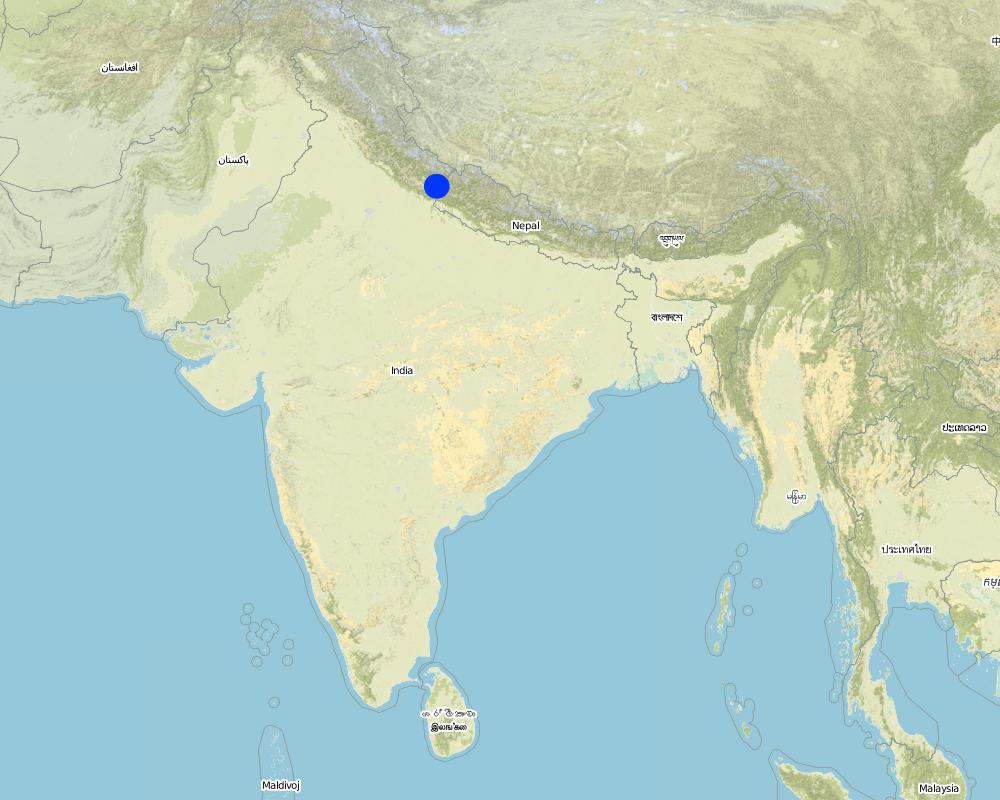Naula Management and Conservation [Энэтхэг]
- Шинийг нээх:
- Шинэчлэх:
- Эмхэтгэгч: Jaclyn Bandy
- Хянан тохиолдуулагч: –
- Хянагч: Hanspeter Liniger
Naula (depression well, indigenous water harvest technology)
approaches_5202 - Энэтхэг
Бүлгүүдийг үзэх
Бүгдийг дэлгэх Бүгдийг хаах1. Ерөнхий мэдээлэл
1.2 Арга барилыг баримтжуулах болон үнэлгээ хийхэд оролцсон хүн эсвэл байгууллагын холбоо барих хаяг
Мэдээлэл өгсөн хүн(с)
Газар ашиглагч:
Jagdamba Joshi
+91 90120 89421
Sarpanch (Chief) of the Nakina Van Panchayat (Forest Council)
Nakina Village, Pithoragarh Bloc, Uttarakhand
Энэтхэг
Газар ашиглагч:
Patni Pooran Chandra
+91 94113 48434 / +91 96395 41519
Digtoli Village
Digtoli Village, Pithoragarh Bloc, Uttarakhand
Энэтхэг
Арга барилыг баримтжуулах/үнэлэх ажилд дэмжлэг үзүүлсэн төслийн нэр (шаардлагатай бол)
Book project: where the land is greener - Case Studies and Analysis of Soil and Water Conservation Initiatives Worldwide (where the land is greener)Арга барилыг баримтжуулах/үнэлэх ажилд дэмжлэг үзүүлсэн байгууллага(ууд)-ын нэр (шаардлагатай бол)
ICIMOD International Centre for Integrated Mountain Development (ICIMOD) - НепалАрга барилыг баримтжуулах/үнэлэх ажилд дэмжлэг үзүүлсэн байгууллага(ууд)-ын нэр (шаардлагатай бол)
G.B. Pant Institute of Himalayan Einvironment & Development (G.B. Pant Institute of Himalayan Einvironment & Development) - Энэтхэг1.3 WOCAT-аар баримтжуулсан өгөгдлийг ашиглахтай холбоотой нөхцөл
Мэдээллийг хэзээ (газар дээр нь) цуглуулсан бэ?
18/06/2019
Эмхэтгэгч болон гол мэдээлэгч хүн(хүмүүс) WOCAT аргачлалаар баримтжуулсан мэдээллийг ашиглахтай холбоотой нөхцлийг хүлээн зөвшөөрсөн:
Тийм
1.4 ГТМ-ийн технологийн асуулгын(д) суурь мэдээлэл(д)
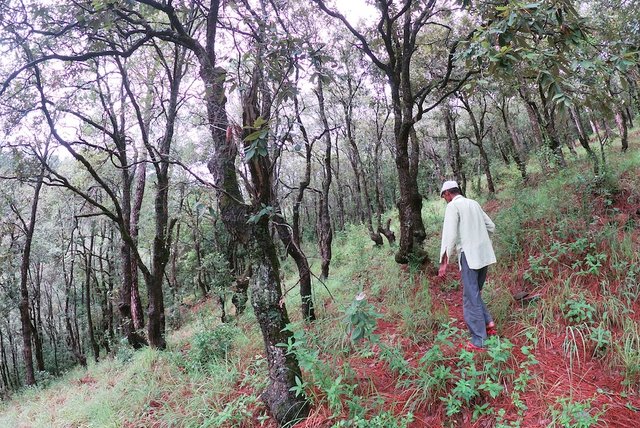
Broadleaf Plantations, Assisted Tree Regeneration and Fodder Nurseries … [Энэтхэг]
Natural assisted regeneration of broadleaved species, a small oak plantation and a fodder nursery have been established in the Nakina community forest (intervention area: 10 ha), supporting fodder tree species such as Banj Oak and Falyaat, as well as various subtropical temperate fodder grass species. This has improved the livelihood …
- Эмхэтгэгч: Jaclyn Bandy
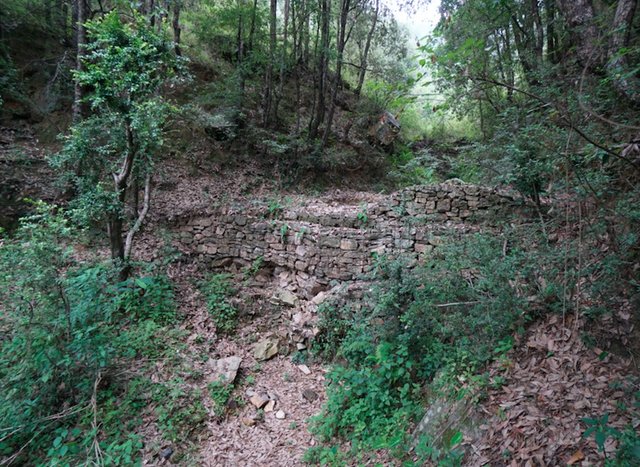
Stone Check Walls and Check Dams for Soil … [Энэтхэг]
Stone Check Dams/Walls, Retainment Walls, and a Water Diversion Wall has been constructed in Nakina Village and Nakina Community Forest to help protect their settlements, agriculture land, forest land, and preserve the hilly landscape. These structures serve to reduce the runoff velocity (lowering the rate of erosion and gullying in …
- Эмхэтгэгч: Jaclyn Bandy
2. ГТМ Арга барилын тодорхойлолт
2.1 Арга барилын товч тодорхойлолт
Naulas are shallow, four-sided stepped wells designed to collect water from subterranean seepages or springs and are used to meet domestic water needs by the local communities. Naula management and conservation encompasses a range of activities that preserve their structure and function.
2.2 Арга барилын дэлгэрэнгүй тодорхойлолт
Арга барилын дэлгэрэнгүй тодорхойлолт:
Naulas are imperative sources of natural seepage of drinking water and are considered the most important hydraulic structures to the villages in hill regions of Uttarakhand. They appear as a dry stone masonry structure, normally with a four-sided (rectangle or square) shape with stairs on all the sides and are commonly covered by stone slates and an erected wall on three sides. Since ancient times, water rituals are practiced within the communities and the water from these naulas have idols of various deities like the sun, moon, Earth, Vishnu, Ganesh etc. The main motive of keeping idols of gods and goddesses tied to the naulas is to preserve these structures from pollution and other harmful anthropogenic activities.
The efforts to preserve naulas include; building structural or vegetative barriers on the slope above to prevent physical damage, pollution from runoff and other erosive processes, establishing barriers of entry to deter wildlife and insects, initiating cleaning routines in the villages (scrubbing/disinfecting and clearing debris or weeds around the naulas).
The villages of Nakina, Digtoli, and Bhurmuni have carried out their own traditional measures to conserve these sacred structures and the water that flows into them. Sacred tree species like the peepal and banyan trees have been planted near naulas to signify its sanctity and to protect and shade it. To ensure the potability of a naula's water, biweekly cleaning regimes are undertaken. Structural measures such as check walls, check dams, and water channels have been made above the naulas. Additionally, wildlife entry is inhibited with cloth drapes that cover the naula's entrance, and some villages have established a protective enclosure around the naula.
Routine Naula conservation activities are taken up by those that collect the water, which include mainly the women and children. There is a water queue system in Nakina Village, in which people receive a specific time slot to take the water from the naula. This helps with keeping track of water use and promotes equitable use of water in the village. Other arduous tasks such as constructing the structural technologies include male participation. Monthly or bimonthly community meetings and daily checks on the Naulas help enforce the approach objectives. The villagers are are the sole stakeholders and take up full ownership and water user rights.
Generally, the older community members in these villages stress the need of Naula conservation and management to a greater degree. Members of the younger generation are less concerned and do not exhibit the same level of sensitivity, although they are aware of their importance to the community. The future effectiveness of the approach will depend on village participation and the level of dependency on the Naula for water during the dry season. With the drying of springs and increased use of pipe-schemes (though unreliable), external sources of water may replace this indigenous water harvesting technique.
2.3 Арга барилын зурагууд
2.5 Арга барил нэвтрүүлсэн улс орон / бүс нутаг / байршил
Улс:
Энэтхэг
Улс/аймаг/сум:
Uttarakhand
Байршлын дэлгэрэнгүй тодорхойлолт:
Digtoli, Pithoragarh Bloc
Тайлбар:
Villages: Digtoli, Nakina, Bhurmuni
Map
×2.6 Арга барилыг эхлэх, дуусах огноо
Хэрэв арга барилыг хэрэгжүүлэх жил тодорхойгүй бол ойролцоогоор эхлэх огноог зааж өгнө үү:
>50 жилийн өмнө (уламжлалт)
2.7 Арга барилын төрөл
- уламжлалт / уугуул
2.8 Арга барилын үндсэн зорилго, зорилтууд
Maintenance and preservation of the indigenous water harvesting technology, the naula. By protecting this structure and the catchment area around it, the villages can protect their precious water resources and sustain a long-lasting tradition.
2.9 Арга барилын хүрээнд хэрэгжсэн Технологи/Технологиудад дэмжсэн эсвэл саад учруулсан нөхцлүүд
нийгэм / соёл / шашны хэм хэмжээ, үнэт зүйлс
- Идэвхижүүлэх
Various religious ceremonies/rituals are still carried out around the naulas to this day. Lord Vishnu is associated with water in Hindu scriptures and mythology. Hence many naula have idols of Vishnu installed in them or sculpted on their stone walls. The need to revere and care for the naula is stressed by older generations.
- Хазаарлалт
Due to shifting cultural dimensions, government or office jobs are considered to have a higher status than that of farmers in rural areas. These days rural youth have their minds set on getting a government or an office job. They are not willing to toil on their farms. This is severely straining the traditional systems of
managing common property resources
санхүүгийн нөөц, үйлчилгээний хүртээмж / боломж
- Идэвхижүүлэх
Little external financial resources are required
- Хазаарлалт
Less attention/investment is being directed to natural resources due to outmigration an off-farm employment opportunities
Бүтэц зохион байгуулалт
- Хазаарлалт
With better education and the increasing share of non-farm economy in the national economy, the potential for obtaining off-farm employment is growing rapidly. Non-farm employment (NFE) has affected traditional water management systems. NFE opportunities, particularly for rural males, have changed the traditional occupation structures in the villages. When a family's reliance shifts from agriculture to an off-farm source of income, its incentive to participate in the traditional voluntary chores required to maintain common property resources decreases. This reduces the supply of voluntary labor for tasks like the management and maintenance of naulas. Traditional sanctions against such households are less effective, thereby eroding local norms and authority. Families that are headed by women when the male head is away have difficulty in obtaining their rightful share of water. Interfamily disputes erupt on the return of the male heads, reducing the community's unity that is so essential for managing common property resources.
талуудыг хамтын ажиллагаа/зохицуулалт
- Идэвхижүүлэх
The approach is traditionally community driven, site specific and requires little to no external input from other actors outside of the village.
Хууль, эрхзүйн хүрээ (газар эзэмшил, газар, ус ашиглах эрх)
- Идэвхижүүлэх
There are no formal institutions or rules/written records of water rights and devices for regulating water use and their flow structures. In most traditional settings, water rights of individuals users are known, even if they are not formally recorded. In general all users are expected to participate in operation, maintenance and cleaning chores.
- Хазаарлалт
In the absence of formal records, however, this can be variable depending on the village.
Бодлогууд
- Идэвхижүүлэх
According to traditional law, communities have had the ownership, control and rights to these water resources. They have had the freedom to build a variety of water harvesting structures based on their experiential knowledge and have designed them to fulfill their needs. Although the Kumaon Water
Rules of 1917 transferred ownership of water resources to the state, the colonial government did not enact any specific legislation for water in the Uttarakhand region. As a result, village communities continued to look after their naulas and other water harvesting structures.
Газрын засаглал (шийдвэр гаргах, хэрэгжүүлэх, шаардлага)
- Идэвхижүүлэх
Traditional water collecting systems in Uttarakhand comprise a variety of community control methods. Their assortments started from the differences in the local circumstances. Many of these plans were
initially made by local leaders, dynasties and kings or by the prosperous people of the society. They display a diversity of technologies and minimal state intervention in water rights or management.
- Хазаарлалт
Sometimes, these systems failed to ensure social justice. Caste discrimination, appears to be a common feature. In many locations, there are separate naulas for people of upper and lower castes. The
ones for the lower castes are usually smaller and unadorned structures by comparison. Care and maintenance is irregular and a large number are in a decrepit state.
ГТМ-ийн талаарх мэдлэг, техникийн дэмжлэг авах боломж
- Идэвхижүүлэх
ажлын багтаамж, хүн хүчний нөөц бололцоо
- Идэвхижүүлэх
Naulas are typically close to the village (<500m), therefore combined community efforts make the workload and execution of this approach manageable, assuming their is collective participation.
3. Оролцогч талуудын оролцоо ба үүргүүд
3.1 Арга барилд оролцогч талууд болон тэдгээрийн үүргүүд
- Орон нутгийн газар ашиглагч / орон нутгийн иргэд
Nakina, Digtoli, and Bhurmuni Village
Local village authorities hold regular meetings with the people to organize, discuss and monitor the use/status of their water resources and naula structures/
3.2 Арга барилын янз бүрийн үе шатанд орон нутгийн газар ашиглагчид / бүлэглэлүүдийг татан оролцуулах
| Орон нутгийн газар ашиглагч / орон нутгийн иргэдийн оролцоо | Хэн оролцсоныг тодорхойлж, үйл ажиллагааг тайлбарлана уу | |
|---|---|---|
| санаачлага/идэвхжүүлэлт | өөрийн хүчийг нэгтгэсэн | Village heads, community members, Nakina Van Panchayat (community forest council) |
| Төлөвлөгөө | өөрийн хүчийг нэгтгэсэн | Village heads organize a Gram Sabha (a meeting of all villagers in each village council area) and fulfill their obligations in local resource decision-making with active community participation. |
| Хэрэгжилт | өөрийн хүчийг нэгтгэсэн | |
| Мониторинг/ үнэлгээ | өөрийн хүчийг нэгтгэсэн | |
| үгүй |
3.4 ГТМ-ийн технологи/технологиуд сонгох шийдвэр
Хэрэгжүүлэх Технологи/Технологиудын сонголтыг хийж шийдвэр гаргасан хүнийг тодорхойлно уу:
- Газар ашиглагч дангаараа (өөрийн санаачлага)
Тайлбар:
This is a traditional model of community-driven, decentralized water governance. It is both replicable and sustainable depending on the village's particular leadership, culture, tradition and politics.
Шийдвэрийг юунд үндэслэн гаргасан:
- Хувь хүний туршлага ба санал бодол (баримтжуулаагүй)
4. Техникийн дэмжлэг, чадавхи бүрдүүлэх, мэдлэгийн менежмент
4.1 Чадавхи бэхжүүлэх/сургалт
Газар эзэмшигчид / бусад оролцогч талуудад сургалт явуулсан уу?
Үгүй
4.2 Зөвлөх үйлчилгээ
Газар ашиглагчдад зөвлөх үйлчилгээ авах боломжтой байдаг уу?
Тийм
Зөвлөх үйлчилгээ үзүүлсэн эсэхийг тогтоо:
- Газар ашиглагчийн талбай дээр
- Тогтмол төвд
Тодорхойлолт / тайлбар:
There are several active organizations/ advisory services that are frequently engage with and are available to the communities. Some of these organisations include G.B. Pant, the Forest Department, and NGOs: Himalayan Sewa Samiti, CHEA, Swati Gramodyog Sansthan.
4.3 Институцийг бэхжүүлэх (байгууллагын хөгжил)
Арга барилаар дамжуулан институц байгуулагдаж эсвэл бэхжсэн үү?
- Тийм, дунд зэрэг
Байгууллагууд бэхжиж, үүсэн бий болсон түвшин(үүд)-г тодорхойлно уу:
- Орон нутгийн
Байгууллага, үүрэг, хариуцлага, гишүүд гэх мэтийг тайлбарлах:
Nakina village and Nakina Van Panchayat (community forest council) in particular have strengthened their relationships with external institutions and have been receptive to new projects for sustainable water management and natural resource use. This has increased involvement of the community and strengthened approach participation. Additionally, it has increased awareness and the need for spring restoration interventions and sustainable land use within the catchment areas of the springs/naulas.
Дэмжлэгийн төрлийг ялга:
- Санхүүгийн
- чадавхи бэхжүүлэх / сургалт
4.4 Мониторинг ба үнэлгээ
Мониторинг болон үнэлгээ нь арга барилын хэсэг үү?
Тийм
Тайлбар:
Regular monitoring by the village community
Хэрэв тийм бол энэ баримт бичиг нь мониторинг, үнэлгээнд ашиглагдахаар зориулагдсан уу?
Үгүй
4.5 Судалгаа
Судалгаа арга барилын хэсэг нь байсан уу?
Үгүй
5. Санхүүгийн болон гадаад материаллаг дэмжлэг
5.1 ГТМ-ийн Арга барилын бүрэлдэхүүн хэсгийн жилийн төсөв
Хэрэв жилийн төсөв тодорхойгүй бол хягаарыг тодруулна уу:
- < 2,000
5.2 Газар ашиглагчдад санхүүгийн / материаллаг дэмжлэг үзүүлсэн
Технологи / технологийг хэрэгжүүлэхэд газар ашиглагчид санхүүгийн / материаллаг дэмжлэг авсан уу?
Үгүй
5.3 Тодорхой зардлыг даахад чиглэсэн дэмжлэгт (хөдөлмөрийн хүчийг оролцуулаад)
Хэрэв газар ашиглагчийн хөдөлмөрийн хүч чухал байсан бол энэ нь аль хэлбэр байсан:
- сайн дурын
5.4 Кредит
Арга барилын хүрээнд ГТМ-ийн үйл ажиллагаанд зориулж зээлд хамрагдсан уу?
Үгүй
5.5 Бусад урамшуулал, хэрэгсэл
ГТМ-ийн технологийг хэрэгжилтийг дэмжихэд ашигласан бусад урамшуулал, хэрэгсэл байсан уу?
Тийм
Хэрэв тийм бол, тодруулна уу:
The World Bank aided Uttarakhand Decentralized Watershed Development Project (GRAMYA) implemented by Watershed Development Directorate of Uttarakhand
Government. It is operating since 2005 with the aim to mitigate water problems and addressing issues of other natural resources, with emphasis on women participation.
NITI Aayog (National Institution for Transforming India), Government of India has recently launched a National Programme on Regeneration of Springs in the Himalayan Region 2017).
6. Нөлөөллийн дүн шинжилгээ ба дүгнэлт
6.1 Арга барилын нөлөөллүүд
Арга барил нь орон нутгийн газар ашиглагчдыг чадваржуулах, оролцогч талуудын оролцоог сайжруулсан уу?
- Үгүй
- Тийм, бага зэрэг
- Тийм, зарим
- Тийм, их
Increased awareness of naula importance; enhanced collaborative water conservation and use within the community
Арга барил нь нотолгоонд суурилсан шийдвэр гаргах боломж олгосон уу?
- Үгүй
- Тийм, бага зэрэг
- Тийм, зарим
- Тийм, их
Traditional approaches encompass ecosystem thinking, and therefore good practices such as planting trees above the naula and creating a favorable environment in the catchment area have been adopted by these communities for many generations. Though there has been improvements in infrastructure, officially provided water supply systems have either not reached the remote rural villages or where provided are unreliable, poorly maintained, and not the preferred source of drinking water.
Арга барил нь ГТМ-ийн технологийг хэрэгжүүлж, хадгалахад газар ашиглагчдад тусласан уу?
- Үгүй
- Тийм, бага зэрэг
- Тийм, зарим
- Тийм, их
Increased sensitivity to the importance and impact of the surrounding ecosystem to the springs/naula function.
Арга барил нь ГТМ-ийн зардал хэмнэсэн хэрэгжилт, зохицуулалтыг сайжруулсан уу?
- Үгүй
- Тийм, бага зэрэг
- Тийм, зарим
- Тийм, их
The approach supported community ecosystem-based thinking and has extended to interventions with the Nakina Van Panchayat (community forest council)
Арга барил нь ГТМ-ийн хэрэгжилтийн санхүүгийн эх үүсвэрийн хүртээмжийг сайжруулах / эргэлтэнд оруулахад чиглэсэн үү?
- Үгүй
- Тийм, бага зэрэг
- Тийм, зарим
- Тийм, их
Active participation of the community and strong organizational qualities have helped extend their network and resource base
Арга барил нь ГТМ хэрэгжүүлэхэд газар ашиглагчдын мэдлэг, чадварыг сайжруулахад хүргэсэн үү?
- Үгүй
- Тийм, бага зэрэг
- Тийм, зарим
- Тийм, их
This approach increased engagement and refined attention to their main drinking water resources. Because spring discharge is decreasing, people have started to extend interventions in the microwatersheds or catchment areas of the springs for ground water recharge. This includes establishing plantations, avoiding overgrazing in the forests, and building recharge ponds and trenches.
Энэ арга барил бусад сонирхогч талуудын мэдлэг, чадавхийг сайжруулсан уу?
- Үгүй
- Тийм, бага зэрэг
- Тийм, зарим
- Тийм, их
Increased the combined interest of village-institution cooperation to understand the hydrogeological science behind spring recharge and develop recharge schemes to improve water security.
Арга барил нь оролцогч талуудын хооронд институци, хамтын ажиллагааг бий болгож, бэхжүүлсэн үү?
- Үгүй
- Тийм, бага зэрэг
- Тийм, зарим
- Тийм, их
ICIMOD, G.B. Pant, the Forest Dept., and local NGOS are improving the merging of their efforts when working with particular communities that are open and curious to new projects and scientific technologies.
Энэ арга барил зөрчилдөөнийг багасгасан уу?
- Үгүй
- Тийм, бага зэрэг
- Тийм, зарим
- Тийм, их
There is a systematic organization of naula use and care in the villages, which is generally obeyed and thus conflict is avoided.
Арга барил нь эмзэг бүлгийнхнийг нийгэм, эдийн засгийн хувьд чадавхижуулсан уу?
- Үгүй
- Тийм, бага зэрэг
- Тийм, зарим
- Тийм, их
Upper caste members in the villages continue to determine social inclusion/exclusion with access to water sources. The culture excludes the Dalits in Chuni (lower castes) from accessing or using any Naula in the village except the one that is assigned as theirs. Despite this, the naulas of the lower caste are still considered important for management and conservation.
Арга барил нь жендэрийн тэгш байдлыг сайжруулж, эмэгтэйчүүд, охидыг чадавхжуулсан уу?
- Үгүй
- Тийм, бага зэрэг
- Тийм, зарим
- Тийм, их
Improved the realization and need for woman empowerment in decision-making for the water resource use and management. Women in Nakina village feel comfortable to speak up and voice their concerns in group discussions. However, when the water in the naulas reduces, women are still blamed for accessing the spring in an "impure" condition (when menstruating) and are consequently banned from using the naula and sent to live in small huts outside the domains of the main house.
Арга барил нь газар ашиглагч залуучууд / дараагийн үеийн хүмүүсийг ГТМ-д оролцохыг хөхүүлэн дэмжсэн үү?
- Үгүй
- Тийм, бага зэрэг
- Тийм, зарим
- Тийм, их
The approach has gained momentum for participation in preservation and restoration of naula structures. If water scarcity persists, the next generation can't expect to make a sustainable livelihood in their home villages.
Арга барил нь чанаржуулсан шим тэжээл/ хүнсний аюулгүй байдалд хүргэсэн үү?
- Үгүй
- Тийм, бага зэрэг
- Тийм, зарим
- Тийм, их
Increased available water supply for small vegetable patch watering and water for livestock
Арга барил нь ус, ариун цэврийн байгууламжийн хүртээмжийг сайжруулахад хүргэсэн үү?
- Үгүй
- Тийм, бага зэрэг
- Тийм, зарим
- Тийм, их
Decreased risks of pollution from run off, water-born diseases and water availability
Арга барил нь газар ашиглагчид уур амьсгалын өөрчлөлтөд дасан зохицох чадварыг дээшлүүлж, уур амьсгалын өөрчлөлттэй холбоотой гамшгийг бууруулах чадавхийг сайжруулсан уу?
- Үгүй
- Тийм, бага зэрэг
- Тийм, зарим
- Тийм, их
Decreased effects and damage of extreme weather events on naula structure (e.g. reduced impact of erosion and pollution from run-off, protection from fire)
6.2 ГТМ-ийг хэрэгжүүлэх газар ашиглагчидын гол санаачилга
- Газрын доройтол буурсан
The people are aware of the implications that land degradation have on their water resources.
- Ажлын ачаалал бууруулсан
Preservation and protection of a naula results in less work than repairing a physically damaged naula
- дүрэм журам (торгууль) / сахиулах
There is a strictly enforced rotation system to use the Naula at given times in the dry season (morning: 7-9am), (evening: 6-8pm). Penalties result for violating these rules.
- нэр хүнд, нийгмийн дарамт / нийгмийн холбоо
The approach builds more equity into the community
- Сүлжээ/ бүлэг төсөл/ хөдөлгөөнд гишүүнээр элсүүлэх
With collective ownership of natural resources, villagers build better relationships among neighbors. With more resources and access to water, people are were willing to share and address the needs of others.
- Байгаль орчны ухамсар
- зан заншил, ёс суртахуун
Lord Vishnu is worshipped where naulas are built, and thus the water contained within these nauals is considered a deity.
- ГТМ-ийн мэдлэг, туршлага дээшилсэн
- гоо зүйн сайжруулалт
- зөрчилдөөнийг бууруулах
Responsible and respectable use of this precious resource is essential for conflict mitigation
6.3 Арга барилын үйл ажиллагааны тогтвортой байдал
Газар ашиглагчид арга барилаар дамжуулан хэрэгжүүлсэн арга хэмжээг тогтвортой хадгалж чадах уу (гадны дэмжлэггүйгээр)?
- Тийм
Хэрэв тийм бол яаж гэдгийг тайлбарлана уу:
The community is and has historically been dependent on these water harvesting structures. What has been implemented through the approach needs to be perpetuated for generation to come, along with management of the forests aand other natural resources within the catchments of the springs.
6.4 Арга барилын тогтвортой/давуу тал/боломжууд
| Газар ашиглагчдын тодорхойлсон давуу тал/боломжууд |
|---|
| Improved awareness and action in the community to preserve Naulas; daily users incorporate habitual care and the naulas are well-preserved, clean and respected. Water quality is improved. |
| Increased cohesion of village members and inclusion of women participation with water use and other natural resource management. This is especially recognized in Nakina village. |
| Aesthetic of area is improved, and this is important for spiritual purposes within the communities. Rituals associated with water and naula more appreciated and celebrated. Enhancement of these cultural aspects improves harmony and connectedness within social groups and to nature. |
| Эмхэтгэгч, бусад мэдээлэл өгсөн хүмүүсийн өнцгөөс тодорхойлсон давуу тал/боломжууд |
|---|
| Improved understanding of the Naula's respective catchment area (origin of water source/storage) and the need for SLM practices upstream in springsheds |
| Maintains and strengthens social order and awareness of water resource use/requirements |
6.5 Арга барилын дутагдалтай/сул тал/аюул болон тэдгээрийн хэрхэн даван туулах арга замууд
| Газар ашиглагч нарын тодорхойлсон сул тал/ дутагдал/ эрсдэл | Тэдгээрийг хэрхэн даван туулах вэ? |
|---|---|
| If naulas get severely damaged there is hardly anyone in the village today with knowledge of how these structures were constructed and the engineering techniques behind them. | Consultations with older members of the community and with nearby villages could be organized. This would effectively be combined with interventions from institutions like G.B. Pant, who can also combine research efforts on the geohydrology of springs an engineering methods to improve naula/spring discharge. |
| 2 years ago, Nakina village members used bleaching powder to clean the naula. A small amount of bleaching powder (2 teaspoons) was suggested for each Naula (approx Volume: 1mx 1m x 0.8m), however there is no strict monitoring of the water quality. | Now Nakina has recently switched to chlorine tablets, which make measurements easier. They use them about once a month or when there is some incidence of pollution. Traditional methods of naula disinfection could be reintegrated in the cleaning regime (e.g. using the leaves of Amla: Emblica officinalis Gaertn and Neem, Azadirachta indica A Juss) |
| There are times when the water overflows from the confines of the naula structure. | Overflow can be harvested in earthen/ polyethylene ponds or recharge trenches below. |
| Эмхэтгэгч, бусад мэдээлэл өгсөн хүмүүсийн өнцгөөс тодорхойлсон сул тал/ дутагдал/ эрсдэл | Тэдгээрийг хэрхэн даван туулах вэ? |
|---|---|
| In the absence of documentation about the engineering and the science behind the traditional water management systems, it is very difficult to revive these structures once they have been neglected. | Studies that integrate land use changes, traditional knowledge on water management systems, hydrogeological aspects of springs, and potential structural/biological interventions for spring revival need to be implemented with the help of coordinated actors and stakeholders across all agency levels. |
| There are sometimes pipes connected to the naulas leading to reservoirs (storage tanks). The pipes or taps of these reservoirs often have leaks. The community trouble-shoots this issue by plugging the open taps with a fitted wooden stick or ball of plastic trash. There is still significant leakage. | Pipes need to be monitored and repaired; open taps need to be properly plugged (perhaps with a rubber stopper). Twist-taps need to be repaired, and if this is not possible then the leaking droplets can be harvested with a bucket. |
| There is still discrimination of water use within the caste system. Dalits remain excluded from authorities that make decisions about water at the village level. Similarly, women in many villages are still excluded from any decision-making. Both groups are perceived to be highly susceptible in "spoiling" the water collected from nauala structures. | Deep-rooted caste and gender inequities are not simply erased at the local level, despite the policy efforts to improve economic and political mobility within these groups. To equitably improve access to water for the Dalits and women, the root causes of the determinants of social inequity need to be identified, exposed and addressed locally. Nakina village is taking strides to incorporate women and Dalits into decision making processes, as they are the ones remaining in the village. Nakina recognizes this need to involve these formerly excluded groups, as the phenomenon of unidirectional outmigration will simultaneously amplify the necessity of group-cohesion and dedication for sustainable land/resource management . |
7. Суурь мэдээлэл болон холбоосууд
7.1 Мэдээллийн эх үүсвэр/аргууд
- Хээрийн уулзалт, судалгаа
FGD's in Nakina, Digtoli, ad-hoc interviews in Bhurmuni
- Газар ашиглагчтай хийсэн ярилцлага
Village head of Digtoli, Naikina, Bhurmuni
- ГТМ-ийн мэргэжилтэн/шинжээчтэй хийсэн ярилцлага
G.B. Pant (1) Dr. Ranbeer Rawat
7.2 Холбогдох бүтээлийн ишлэл
Гарчиг, зохиогч, он, ISBN:
Traditional Knowledge of Water Management, Rawat A.S., Sah R. 2009, Indian Journal of Traditional Knowledge, Vol. 8(2) pp. 249-254
Хаанаас авч болох вэ? Зардал?
http://nopr.niscair.res.in/bitstream/123456789/3942/1/IJTK%208(2)%20249-254.pdf
7.3 Холбогдох мэдээллийн интернет дэх нээлттэй холбоосууд
Гарчиг/ тодорхойлолт:
Report of Working Group I Inventory and Revival of Springs in the Himalayas for Water Security
URL:
https://niti.gov.in/writereaddata/files/document_publication/doc1.pdf
Холбоос ба модулууд
Бүгдийг дэлгэх Бүгдийг хаахХолбоосууд

Broadleaf Plantations, Assisted Tree Regeneration and Fodder Nurseries … [Энэтхэг]
Natural assisted regeneration of broadleaved species, a small oak plantation and a fodder nursery have been established in the Nakina community forest (intervention area: 10 ha), supporting fodder tree species such as Banj Oak and Falyaat, as well as various subtropical temperate fodder grass species. This has improved the livelihood …
- Эмхэтгэгч: Jaclyn Bandy

Stone Check Walls and Check Dams for Soil … [Энэтхэг]
Stone Check Dams/Walls, Retainment Walls, and a Water Diversion Wall has been constructed in Nakina Village and Nakina Community Forest to help protect their settlements, agriculture land, forest land, and preserve the hilly landscape. These structures serve to reduce the runoff velocity (lowering the rate of erosion and gullying in …
- Эмхэтгэгч: Jaclyn Bandy
Модулууд
Модуль байхгүй байна


